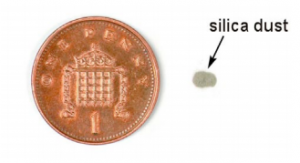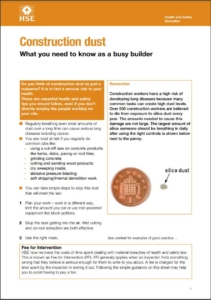DUST. IT CAN KILL - MAYBE NOT TODAY. BUT YEARS DOWN THE LINE.
DON’T RISK YOUR OWN OR YOUR WORKERS LONG-TERM HEALTH. PROTECT LUNGS FROM DUST.
Construction workers die every week from lung diseases caused by exposure to dust. Many more suffer from severe chronic long-term lung conditions.
Don’t make the same mistake as those who have not realised the health risks of exposure to dust and have worked unprotected.
Make sure you are aware of the risks and know what to do to keep you and your workers safe. Read more about HSE’s construction site inspection initiative below, with a focus on respiratory health:
HSE targets construction workers’ lung health with nationwide inspection campaign throughout May, June and July 2023
Failure to prevent life-threatening diseases caused by dust at work is unacceptable, says the Health and Safety Executive (HSE), as it gears up for a summer targeting construction sites across Great Britain.
Supported by HSE’s Dust Kills campaign, which provides free advice to businesses and workers on the control measures required to prevent exposure to dust, the inspections throughout May, June and July will focus on respiratory risks from exposure to dust.
Each year in the construction industry, there are thousands of preventable cases of irreversible lung disease due to past exposure to dust at work. These diseases often have a life-changing impact and can result in an early death.
.jpg)
HSE’s chief inspector of construction, Michael Thomas, said: “Every year we see construction workers die from diseases caused or made worse by their work. This is unacceptable in the 21st century, when occupational lung disease is preventable.
“We are urging employers and workers to take the necessary precautions today to protect their long-term lung health, to avoid them and their families suffering from the devastating impact that can result.”
Starting on Monday, 15 May 2023, the inspections, part of a respiratory health intervention initiative, will specifically focus on dust control, checking employers and workers know the risks, plan their work, and are using the right controls.
Inspectors will be checking the control measures in place to protect workers from inhaling construction dusts including silica (Respirable Crystalline Silica/RCS) and wood dust. They will also gain assurances that asbestos containing materials have been identified and removed or managed where necessary to prevent or reduce exposure.
The initiative is supported by HSE’s Dust Kills campaign. This provides simplified advice and guidance on the Work Right website, for employers, small builders and workers, to help everyone understand the risks and how to stay healthy on site.
The primary aim of the inspection initiative is to ensure workers’ health is being protected. However, if safety risks or other areas of concern are identified, inspectors will take the necessary action to deal with them.
Michael Thomas continued: “Our inspectors will visit a range of construction sites to check businesses are taking the necessary action to ensure their workers’ long-term respiratory health is being protected. Through engaging with those on site, we can make sure they have considered the job from start to finish, have considered the risks at each stage, and are managing the risks with effective measures in line with the broad hierarchy of control options such as water suppression, extraction, and as a last resort Respiratory Protective Equipment (RPE).
For more information visit the Work Right campaign page.
Free Resources
The HSE have created these campaign pages and assets to help make sure you consider all the risks and act now to protect you and your colleagues.
Download our information sheet and ‘what to do as a busy builder’, share it with them and discuss together how to keep everyone safe.
Dust is a silent and sometimes invisable killer.
Dust particles can be 100 times smaller than a grain of sand. You don’t need to see them to breathe them in. Once in your lungs, dust will start causing damage.
Exposure to dust can lead to severe breathing difficulties and lung diseases that can ruin lives and cause an early death.
It can take years before the damage is visible and by then it can be too late. Make sure you are aware of the risks and work in ways that always protect your lung health.
What is construction dust?
Construction dust is generally used to describe different types of dusts that you may find on a construction site. There are three main types of construction dust:
-
Silica dust – created when working on materials containing silica. Materials such as concrete, mortar and sandstone (also known as respirable crystalline silica or RCS)
- Wood dust – created when working on softwood, hardwood and wood-base products like MDF and plywood
- Lower toxicity dusts – created when working on materials containing little or no silica. The most common materials include gypsum – plasterboard, limestone, marble and dolomite
Health Risks
Anyone who works on a construction site or with these types of dusts should know about the risks to their health. The main dust-related diseases are:
- Lung cancer
- Silicosis
- Chronic Obstructive Pulmonary Disease (COPD)
- Asthma
Some diseases such as advanced silicosis or asthma can come on quite quickly. However, most diseases take a long time to develop. The dust can build up in the lungs and harm them over time and the effects are not instantly obvious.
Unfortunately, by the time the effects have been noticed, the damage done may already be life-threatening and it may lead to a permanent disability and early death.
Construction workers have an incredibly high risk of developing these diseases. This is due to many common construction tasks creating high dust levels. Over 500 construction workers are believed to die from silica exposure every year. The amount of dust needed to cause this damage is not large. The largest amount of silica someone should take in a day (after using the right controls) is shown below:

News Archive
HSE News


.png)
.jpg)